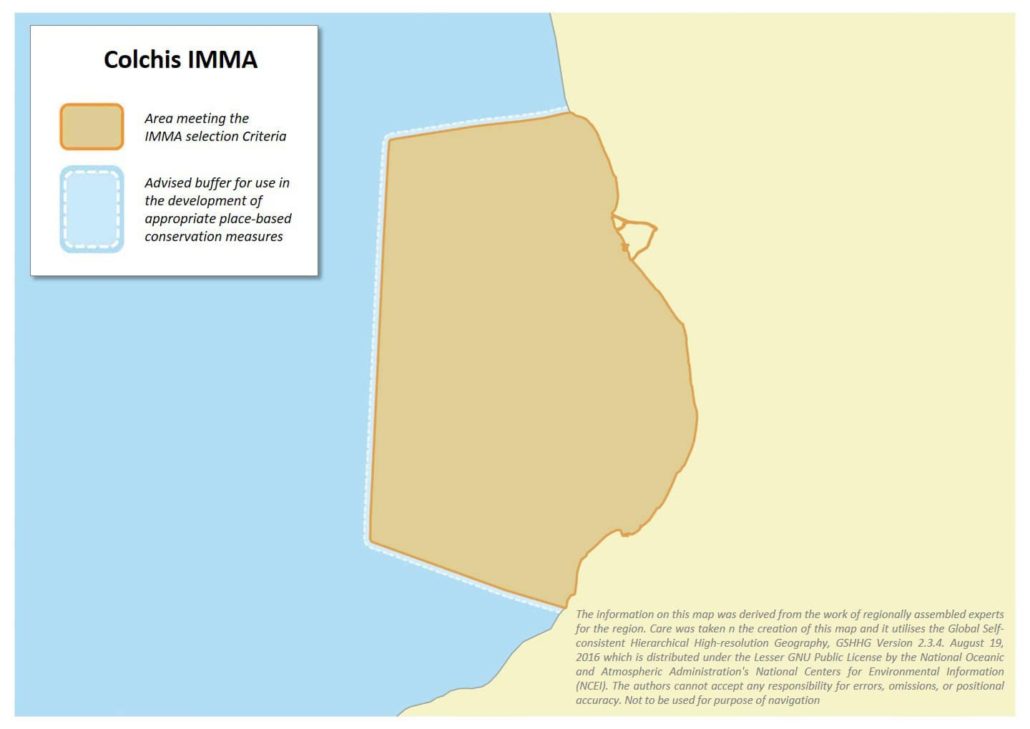Colchis IMMA
Size in Square Kilometres
3 475 km2
Qualifying Species and Criteria
Black Sea Harbour porpoise – Phocoena phocoena relicta
Criterion A, B(2), C(1,2)
Black Sea Common dolphin – Delphinus delphis ponticus
Criterion A, B(2), C(1,2)
Black Sea Bottlenose dolphin – Tursiops truncatus ponticus
Criterion A, C(1,2)
Marine Mammal Diversity
Phocoena phocoena relicta, Delphinus delphis ponticus, Tursiops truncatus ponticus
Download fact sheet
Summary
Colchis IMMA is located in Georgian territorial waters and covers the waters between the Anaklia Cape and and Sarpi (4630 km2). It includes the following habitats: open sea and circulation zone; estuaries; coastal lagoons, shallow waters and bays. The marine area is heavily influenced by the 150 rivers (including minor rivers) that discharge into the sea, and that is why the area is an important wintering ground for harbour porpoises and common dolphins; thousands of them use the marine area in winter and spring. Hundreds of common dolphins and harbour porpoises use the area in summer. Colchis is also important for feeding and breeding for all three Black Sea cetacean species. The mouths of rivers Enguri, Rioni, Khobistskhali, Supsa and Chorokhi are the main feeding grounds.
Description of Qualifying Criteria
Criterion A – Species or Population Vulnerability
Three threatened subspecies of small cetaceans (Tursiops truncatus ponticus, Delphinus delphis ponticus and Phocoena phocoena relicta) are found in the area year-round. The Black Sea harbour porpoise and the Black Sea bottlenose dolphin are both listed as Endangered on the IUCN Red List, and the Black Sea common dolphin population is listed as Vulnerable (Birkun & Frantzis, 2008; Birkun, 2008; Birkun, 2012)
Criterion B: Distribution and Abundance
Sub-criterion B2: Aggregations
The IMMA is a wintering ground for harbour porpoise (Birkun and Frantzis, 2008). Double-platform line transect visual surveys were conducted in this IMMA from 2014 until 2020. Approximately 1,200 (SE=310) animals were recorded in the beginning of autumn 2014, and this increased to around 18,000 (SE=1,329) porpoises present in these waters during the winter 2014. Around 1,200 (SE=310) animals were recorded in the beginning of autumn 2014, and this increased to around 18,000 (SE=1,329) porpoises present in these waters during the winter 2014. In 2016, 16,715 (SE=4902) porpoises were recorded in winter. By comparison, approximately 9,500 (SE=5,574) porpoises were recorded in the area in spring 2016, and 3,200 (SE=825) in summer 2019. (Kopaliani et al., 2015; Kopaliani et al., 2017) Similarly, the IMMA is important aggregation area for common dolphins in winter. Approximately 15,000 (SE=2988) common dolphins were observed to use the IMMA during winter 2014, up to 8,000 (SE=5,234) animals during spring 2016, and approximately 3,700 (SE=1196) in summer 2019 (Kopaliani et al., 2015; Kopaliani et al., 2017) (see Tables 1 and 2 for more details of survey data showing seasonal variations in cetacean numbers).
Criterion C: Key Life Cycle Activities
Sub-criterion C1: Reproductive Areas Evidence that the area is important for cetacean reproduction include: a) observations of courtship behaviour of Tursiops truncatus and Delphinus delphis in May and June (Kopaliani et al., 2015); b) recordings of the all three species with calves under 3 months of age; it is therefore assumed that the area is used for mating and early stages of calf rearing; and c) the finding of stranded harbour porpoises in the late stages of gestation (Kopaliani et al., 2017).
Sub-criterion C2: Feeding Areas In winter and spring, large aggregations of anchovies (Engraulis encrasicolus) use the IMMA as a wintering and spawning area (Chashchin, 1996) and provide harbour porpoises, common dolphins and bottlenose dolphins with abundant food (Birkun, 2008). The mouths of the Enguri, Rioni, Khobistskhali, Supsa and Chorokhi rivers are the main feeding grounds for all three species (Kopaliani et al., 2017).
Supporting Information
Akhalkatsi M. 2010. Habitats of Georgia. Natura 2000. Tbilisi.
Beruchashvili N. & Elizbarasvili N. 2003. Geography of Georgia. Tbilisi (in Georgian).
Birkun Jr., A.A. & Frantzis, A. 2008. Phocoena phocoena ssp. relicta. The IUCN Red List of Threatened Species :2008: e.T17030A6737111. Retrieved from http://dx.doi.org/10.2305/IUCN.UK.2008.RLTS.T17030A6737111.en .
Birkun Jr., A.A. 2008. Delphinus delphis ssp. ponticus. The IUCN Red List of Threatened Species 2008: e.T133729A3875256. Retrieved from http://dx.doi.org/10.2305/IUCN.UK.2008.RLTS.T133729A3875256.en .
Birkun, A. 2012. Tursiops truncatus ssp. ponticus. The IUCN Red List of Threatened Species 2012: e.T133714A17771698.Retrieved from http://dx.doi.org/10.2305/IUCN.UK.2012.RLTS.T133714A17771698.en
Chashchin A.K. 1996. The Black Sea populations of anchovy. Scientia Marina, 60 (Supl.2): 219-228.
Kopaliani N., Gurielidze Z., Devidze N., Ninua L., Dekanoidze D., Javakhishvili Z., Paposhvili N., Qerdikoshvili N. 2015. Monitoring of Black Sea Cetacean in Georgian Waters (Report). Supported by Kolkheti National Fund. Adopted by Ministry of Natural Resources and Environment Protection of Georgia (in Georgian)
Kopaliani N., Gurielidze Z., Devidze N., Ninua L., Dekanoidze D., Javakhishvili Z. 2017. Implementation of the Action Plan for the Conservation of Black Sea Cetacean. Supported by Kolkheti National Fund. Adopted by Ministry of Natural Resources and Environment Protection of Georgia (in Georgian)
Kopaliani, N., Gurielidze, Z., Devidze, N., Shakarashvili, M. 2016. Action Plan for the Conservation of Black Sea Cetacean. Supported by Kolkheti National Fund. Adopted by Ministry of Natural Resources and Environment Protection of Georgia (available in English).


